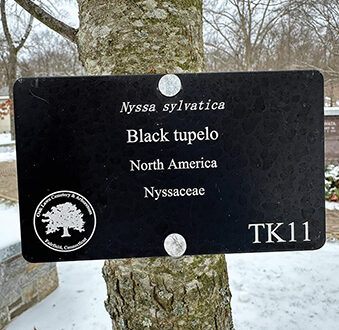We list only mechanical control options below. Many thanks to Emmett Varricchio for developing the calendar. See it in full on the CIPWG website at cipwg.uconn.edu under 2018 Symposium Presentations.
If you don’t get to it at the prescribed time, just remember that the best time to manage invasives is NOW!
CUT/MOW: Delays/prevents seed production and depletes plant’s resources. Follow-up often as necessary. Repeated mowing is an effective control strategy for some plant species.
PULL/DIG: Effective at removing seedlings and annuals. Organize volunteers and have a pulling party.
Japanese Knotweed (Polygonum cuspidatum)
Cut/mow mid-May to mid-June: Schedule three to four times a year. Can be effective, but don’t leave cuttings to root!
Oriental Bittersweet (Celastris orbiculatus)
Cut/mow anytime: Effective at stopping growth. Plants respond by sending out more shoots so follow-up necessary. Pull/dig anytime: Effective for young plants.
Japanese Barberry (Berberis thunbergii)
Cut/mow anytime. Effective at clearing forest understory and preventing fruiting, but plants respond by sending out new shoots. *Pull/Dig anytime: Use crowbars and handpullers to remove large plants. Pull seedlings to save time later. Disposal: Leave plants to compost on site if fruit isn’t present/mature.
Multiflora Rose (Rosa multiflora)
Cut/mow anytime. Mowing’s effective at clearing and preventing flowering. Cutting down in winter makes it easier to access site. *Pull/dig anytime: Effective but labor intensive. Disposal: Plants can be composted if mature fruits aren’t present.
Mugwort (Artemisia vulgaris)
Cut/mow anytime. Repetitive mowing may (or may not) control. Mow right before/during flowering to stop seed production. Pull/dig anytime. Only effective in small areas due to extensive rhizomes.
Garlic Mustard (Alliaria petiolata)
*Pull second-year plants in spring months before flowers begin to elongate, and first-year plants in the fall. Cut/mow anytime . Disposal: Leave plants to dry on site if not in flower.
Autumn Olive (Elaeagnus umbellata)
Cut/mow anytime. Effective at preventing fruiting. Plants respond by sending out more shoots so follow-up is necessary. Pull/dig anytime: Effective for young plants. Disposal: Remove trees with mature fruit from site to prevent fruit dispersal. Note: Leaf-out occurs early and plants can be identified by their silver-tinted leaves.
Common Reed (Phragmites australis)
*Cut/mow anytime. Effective at slowing the spread. Pull/dig anytime. Can be effective but it’s labor intensive.
Mile-a-Minute Vine (Persicaria perfoliata)
*Cut/mow anytime: weed whacking is also effective at preventing flowering. Pull/dig anytime: Pulling early in the season, before flowering, can reduce the population considerably. Seeds can survive upwards of seven years in soil so follow-up as necessary. Biocontrol: Mile-a-Minute weevil (Rhinoncomimus latipes) has been released to control MAM populations in Connecticut. Disposal: Leave bagged plants on site to allow the weevils to pupate and fly away. Tips: Return to sites every year to evaluate MAM population size.
Black Swallow-wort (Cynanchum louiseae)
Cut/mow anytime. Effective if done continuously during year. *Pull/dig anytime: effective but labor intensive. Large perennial root system makes pulling difficult. Note: Monarch butterflies will lay eggs on them, but the larvae will die.
* Most effective management technique




